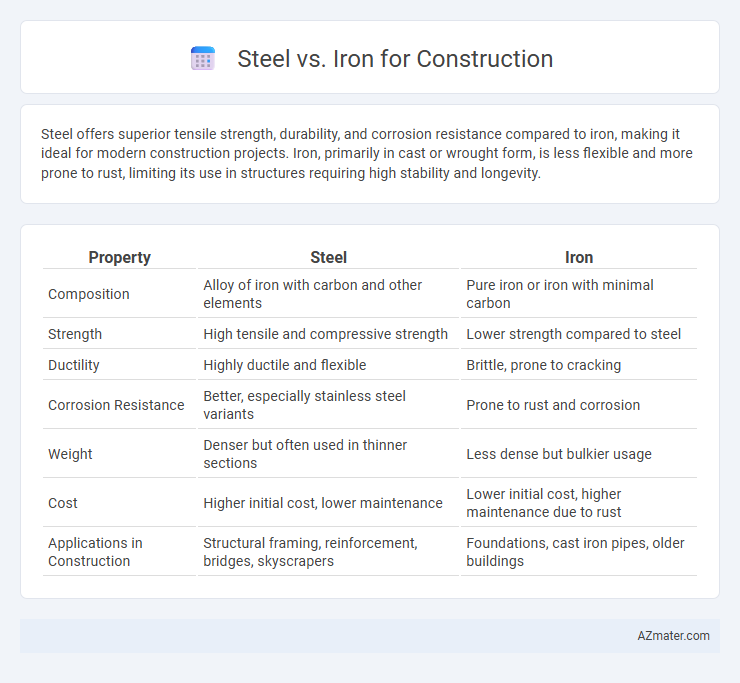Steel offers superior tensile strength, durability, and corrosion resistance compared to iron, making it ideal for modern construction projects. Iron, primarily in cast or wrought form, is less flexible and more prone to rust, limiting its use in structures requiring high stability and longevity.
Table of Comparison
| Property | Steel | Iron |
|---|---|---|
| Composition | Alloy of iron with carbon and other elements | Pure iron or iron with minimal carbon |
| Strength | High tensile and compressive strength | Lower strength compared to steel |
| Ductility | Highly ductile and flexible | Brittle, prone to cracking |
| Corrosion Resistance | Better, especially stainless steel variants | Prone to rust and corrosion |
| Weight | Denser but often used in thinner sections | Less dense but bulkier usage |
| Cost | Higher initial cost, lower maintenance | Lower initial cost, higher maintenance due to rust |
| Applications in Construction | Structural framing, reinforcement, bridges, skyscrapers | Foundations, cast iron pipes, older buildings |
Introduction to Steel and Iron in Construction
Steel and iron are fundamental materials in construction, each possessing unique properties that influence their application. Iron, primarily used in its cast or wrought forms, offers excellent compressive strength but lacks the tensile strength and flexibility provided by steel, which is an alloy of iron and carbon. Steel's enhanced durability, corrosion resistance, and versatility make it the preferred choice for modern structural frameworks and infrastructure projects.
Historical Uses of Steel and Iron in Building
Iron's use in construction dates back to ancient times, with wrought iron prominently featured in early bridges and structural frameworks due to its malleability and strength. The Industrial Revolution marked a pivotal shift as steel, produced through the Bessemer process, became the preferred material for skyscrapers and large infrastructure projects because of its superior tensile strength and durability. Historical landmarks like the Eiffel Tower and Brooklyn Bridge showcase the evolution from iron to steel, reflecting advancements in metallurgy that significantly enhanced building capabilities.
Chemical Composition: Steel vs Iron
Steel primarily consists of iron with a carbon content ranging from 0.02% to 2.14%, which significantly enhances its strength and flexibility compared to pure iron. Iron, especially in its pure form (wrought iron), contains less than 0.1% carbon, making it softer and more malleable but less durable under stress. The controlled addition of carbon and other alloying elements like chromium or nickel in steel modifies its chemical composition, resulting in improved corrosion resistance and mechanical properties vital for construction applications.
Strength and Durability Comparison
Steel exhibits significantly higher tensile strength compared to iron, making it ideal for modern construction requiring load-bearing capacity and flexibility. Its superior durability is evident in resistance to corrosion, fatigue, and environmental stress, extending the lifespan of structures. Iron, particularly cast iron, is more brittle and prone to cracking under stress but remains useful for non-load-bearing architectural elements and decorative features.
Structural Performance in Modern Construction
Steel outperforms iron in structural performance for modern construction due to its superior tensile strength, ductility, and corrosion resistance. The high strength-to-weight ratio of steel enables the design of taller, more resilient buildings and infrastructure while maintaining material efficiency. Advanced steel alloys and fabrication techniques further enhance durability, seismic resistance, and flexibility compared to traditional iron components.
Cost Analysis: Steel vs Iron
Steel generally offers a higher upfront cost compared to iron due to its complex manufacturing process and added alloy elements enhancing its strength and versatility. Iron, particularly cast iron, remains cheaper but lacks the tensile strength and flexibility steel provides, often leading to increased long-term maintenance expenses. When analyzing total cost of ownership in construction, steel's durability and lower repair rates typically result in better cost efficiency over iron.
Corrosion Resistance and Maintenance Needs
Steel offers superior corrosion resistance compared to iron due to its alloy composition, often including chromium and nickel, which form a protective oxide layer. Iron is prone to rust and requires frequent maintenance such as painting or coating to prevent degradation. Structures made from steel typically have lower long-term maintenance costs and greater durability in corrosive environments.
Sustainability and Environmental Impact
Steel offers superior sustainability in construction due to its high recyclability rate, which can reach up to 90%, significantly reducing landfill waste and demand for raw materials. Iron, while a fundamental raw material, has a higher carbon footprint during extraction and processing compared to modern steel production techniques that increasingly incorporate recycled content and energy-efficient methods. The corrosion resistance and longer lifespan of steel structures contribute to lower environmental impact over their lifecycle, making steel a more eco-friendly choice in sustainable construction.
Application Suitability: When to Use Steel or Iron
Steel offers superior tensile strength, corrosion resistance, and flexibility, making it ideal for high-rise buildings, bridges, and structures requiring durability and seismic resistance. Cast iron, known for its compressive strength and excellent wear resistance, is better suited for decorative elements, piping, and foundations where brittleness is less critical. Choosing steel or iron depends on load requirements, environmental exposure, and cost considerations in construction projects.
Conclusion: Choosing the Right Material for Your Project
Steel offers superior strength, flexibility, and corrosion resistance compared to iron, making it ideal for modern construction projects requiring durability and high load-bearing capacity. Iron, particularly cast or wrought iron, is more suitable for decorative applications or structures with less demanding strength requirements due to its brittleness and susceptibility to rust. Evaluating factors like structural demands, environmental exposure, and budget constraints ensures selecting the right material for project longevity and performance.

Infographic: Steel vs Iron for Construction
 azmater.com
azmater.com